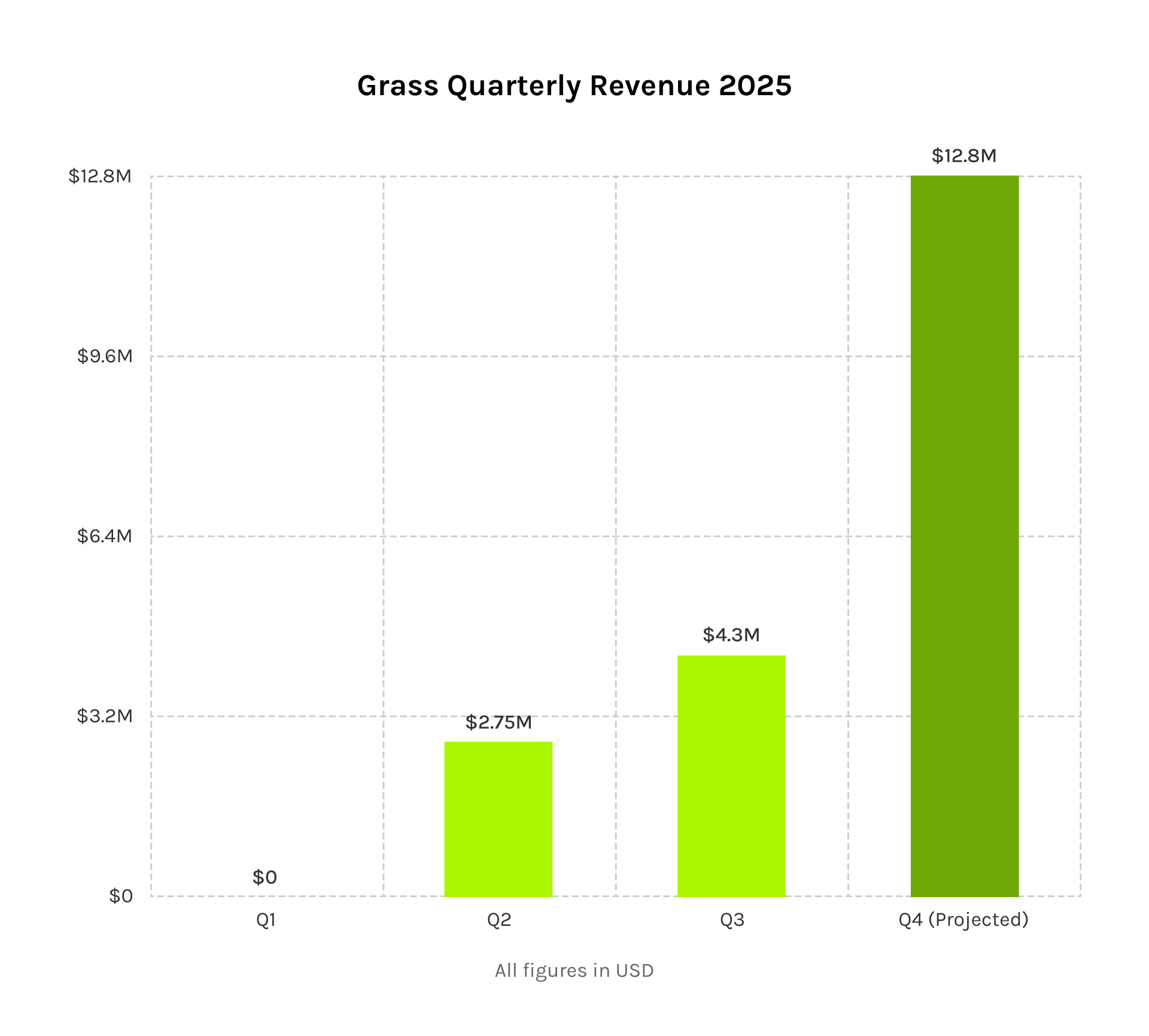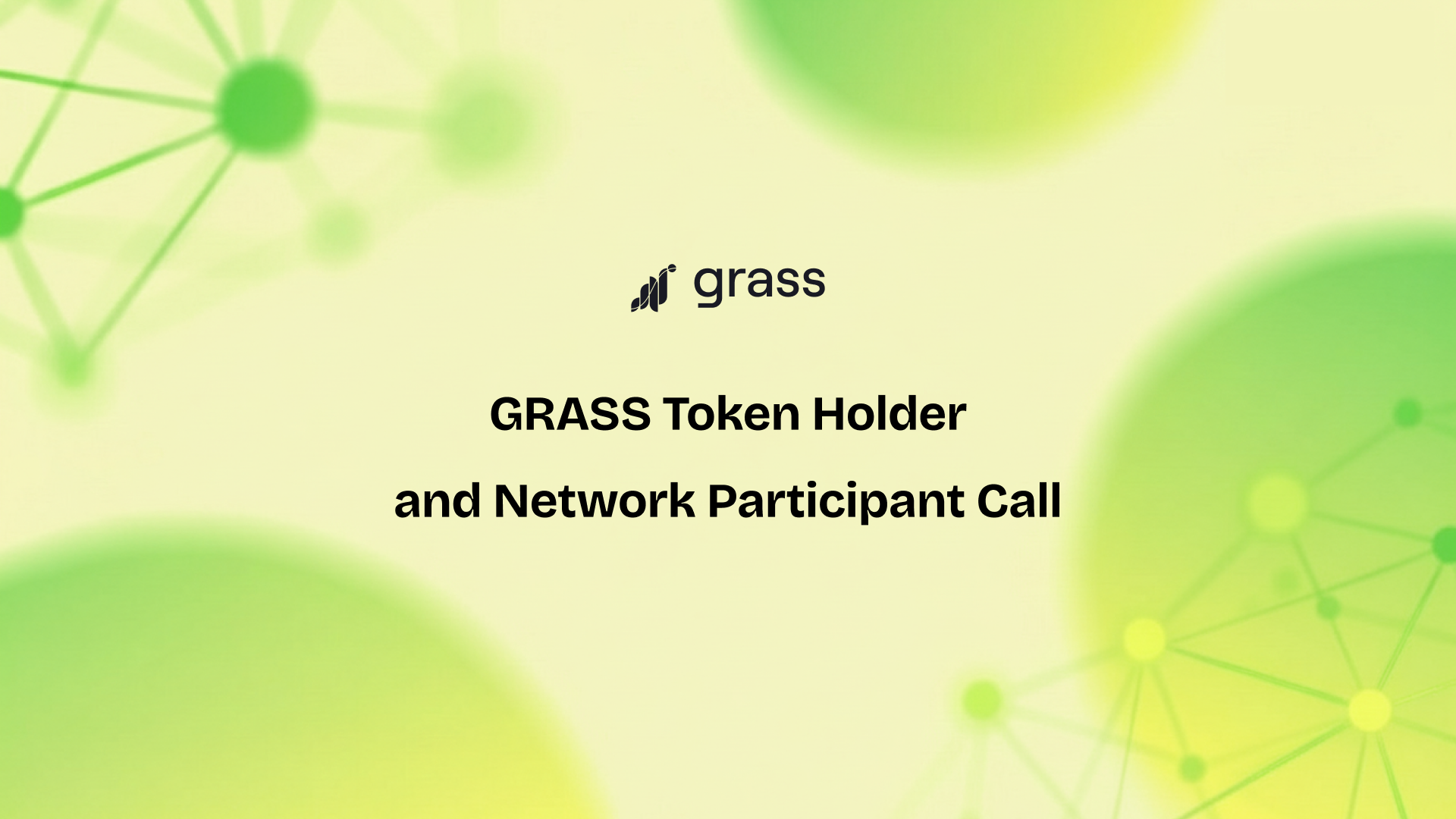For the first time, Grass pulled back the curtain to give a comprehensive and detailed look at the state of the business and the network. We recently hosted our inaugural call for token holders and network participants, covering everything from business performance and network growth to product progress, token direction, and our organizational structure.
Business Overview
Grass has grown from a concept into a revenue-generating network with accelerating performance. It is now among the most widely adopted crypto protocols and a core data infrastructure provider for leading AI companies.
At the start of the year Grass began to actively market its products and services to potential customers for the first time. Grass quickly grew from having close to no meaningful revenue in Q1 of 2025 to approximately $2.75m in Q2. In Q3 Grass generated approximately $4.3M in revenue. In Q4 Grass is projected to generate approximately $12.8M in revenue. These projections are based on an expected revenue of $10M in October and November 2025 based on ongoing business. Certain revenues generated in Q4 are also the result of contracts signed in Q3 with enterprise customers. Grass has been and will continue to reinvest the majority the revenue it generates into growth.
Several commercial milestones shaped 2025 revenue. Earlier in the year, Grass closed enterprise contracts with two major AI organizations, which helped establish the foundation for subsequent growth. In Q3, a channel partner began white labeling Grass’s video downloader. In Q4, Grass closed additional enterprise agreements with a large AI organization and a leading lab in the video generation space. Grass has also seen repeat business from nearly every AI customer, reflecting consistent performance and reliability.
Grass does not disclose the names of AI labs purchasing pre-training data. Training datasets are considered proprietary intellectual property across the industry, and disclosure practices are being shaped primarily by the labs in consultation with regulators. Grass’s role is to operate reliable, confidential infrastructure that supports those standards.

Network and Product Progress
The Grass network has achieved significant milestones, reaching roughly 8.5 million monthly active participants, a substantial increase from the 3 million active users reported at the time of Airdrop One. Crucially, the growth continues to be fueled organically by referrals and natural user discovery.
Mobile adoption played an important role in that expansion. The Grass mobile app, launched earlier this year, has steadily grown its share of total network activity, today, approximately 38% of the network is on mobile. This shift contributes meaningfully to the size and geographic reach of the network.

On the hardware side, the Grasshopper device faced delays due to tariff-driven supply chain constraints earlier in the year. Development work, however, has continued behind the scenes. A detailed update on manufacturing and timing will be released early next year.
Grass’s data infrastructure has also expanded significantly. The multimodal repository now exceeds 250 petabytes of content, a volume sufficient to train a frontier-scale video generation or speech model. Supporting this scale required an intense focus on structural efficiency. Grass successfully established what it believes is the lowest sustainable cost basis for storing and retrieving data within the residential proxy sector. This foundation, combined with an ethical approach to network growth, allows Grass to price its products competitively while delivering consistent quality across various workloads.
Progress continues on Grass’s early real-time data products. A production-ready Search Engine Results Page (SERP) API is currently in trials with three major SEO firms and one leading AI lab, receiving positive early feedback. Internally, this API is considered version zero of Live Context Retrieval (LCR), representing the crucial first step in enabling real-time web context for AI models. Grass anticipates LCR will become an increasingly meaningful segment of the business throughout the year ahead.
Token and On-Chain Direction
Grass has begun incorporating the GRASS token into its broader treasury management strategy. A portion of revenue from data and infrastructure sales is being allocated toward open market purchases of the GRASS token. The initial set of token purchases is being funded from revenue earned in prior quarters, rather than from current-quarter allocations. Approximately $100,000 of purchases were completed last week, with an additional $250,000 currently in progress. The Grass Foundation will publish the wallet address where these tokens will be held.

Grass is seeking to ensure that it has sufficient Grass tokens available to continue distributing Grass tokens to the participants who support the Grass Network. It is also seeking to maintain sufficient reserves of Grass tokens for operational stability and strategic initiatives that will permit Grass to explore and develop additional utility and uses of the Grass token within the Grass ecosystem. The Grass token is essential to the utility and operation of the Grass network. As the network scales, token utility expands across three core areas.
- Functionally, the token is tied to participation in the infrastructure. Staking and delegation determine which routers become operational, which directly affects network performance and capacity. This creates a concrete link between the token and the physical utility of the network.
- The second layer is expanded network utility for the token. As the network expands into Live Context Retrieval, the nature of the workloads changes. Requests to the network become higher-frequency and are made in real-time. This shift makes it possible to move toward programmatic execution based on actual and real-time usage. With Live Context Retrieval, transactions will have smaller and more frequent payment cycles where on-chain settlement becomes natural and viable. This improves accountability and aligns incentives. As participation, routing, and settlement move on-chain, token utility increases in parallel with the network's technical evolution.
- Grass maintains token reserves to support network participation incentives, ecosystem stability, and future utility across network operations as more functionality moves on chain.
Entity Structure
Grass Foundation is an ownerless foundation responsible for stewarding the Grass protocol and ecosystem. It has no shareholders and is structured to prioritize the long term growth of the network and token. The two main operating subsidiaries of Grass Foundation are Grass OpCo Ltd. and Grass DataCo Ltd.
Grass OpCo Ltd. manages all network operations of the Grass network and handles token distributions through the Airdrop Program and Staking Program. Grass DataCo Ltd. operates Grass’s B2B business and receives all revenue from product sales.
Half Space Labs Ltd., which does business under the name Wynd Labs, is a third party service provider to Grass. Wynd Labs supports Grass by providing product and software development, administrative, and business development services to Grass pursuant to a master services agreement. Wynd Labs does not receive any revenues generated by the use of Grass’s products or services and is paid on a fee for services basis. One of the functions of Wynd Labs is to support Grass’s sales efforts with respect to Grass’s products and services. All customer contracts that are sourced by Wynd Labs are signed and entered into by Grass DataCo Ltd. and revenues under those contracts are paid directly to Grass DataCo Ltd.

Looking Ahead
Over the next six to twelve months, Grass will focus on three areas:
- Launching Live Context Retrieval and scaling adoption across enterprise and AI partners.
- Creating a better customer experience by automating and productizing the full stack, from downloading, filtering, routing, and billing, to further increase efficiency and margin.
- Strengthening our position in multimodal data, made possible by our structural cost advantages and operational scale.
As the network scales, Grass is preparing the next iteration of its reward program. Airdrop 2 will be structured to better align incentives with long-term network contribution, with distribution taking place directly through a new native wallet available through the Grass dashboard. The foundation is actively developing this framework, and full details regarding eligibility will be released once the account abstraction based wallet infrastructure is live in the first half of 2026.
Proving what the network can do at scale defined this year. None of that success would have been possible without the people running Grass every day. The work ahead is to execute on the three priorities listed above and continue building a more open internet.
Missed the live session?
Watch the full recording here: https://youtu.be/-6OcK1E2Od4




